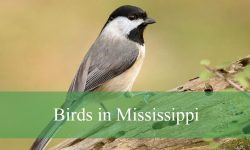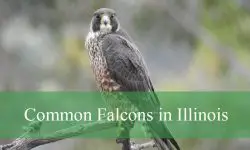In the enchanting world of caterpillars, the most elusive and captivating are those adorned in shades of delicate pink, a spectacle primarily unfolding in the idyllic landscapes of the Eastern United States. These rare creatures, with their ethereal hues, create a stunning tapestry against the backdrop of lush vegetation and diverse ecosystems.
However, the allure of these pink-clad larvae extends beyond the Eastern borders, beckoning exploration into the sun-kissed realms of California and the Southwestern regions. Here, amidst the warm embrace of palm trees and the arid beauty of the landscape, one can uncover the mesmerizing sight of rare pink caterpillars, delicately navigating their way through the fronds.
As with many enchanting tales of transformation, these caterpillars often begin their journey veiled in pink, a subtle camouflage as they conceal themselves beneath the protective cover of leaves. Yet, nature has its way of orchestrating a magical metamorphosis. With the passage of time, these delicate creatures undergo a captivating transformation, exchanging their initial pink cloak for a vibrant green hue. As they ascend to the upper reaches of their host plants, they embark on a voracious feast, consuming every part in their path.
What adds an extra layer of intrigue to these captivating creatures is their tendency to exhibit diverse morphs within the same habitat and growth stage. The harmonious dance of pink and green, coexisting seamlessly, offers a testament to the wonders of biodiversity and adaptation.
An expedition into the territories of these elusive pink caterpillars reveals a nuanced narrative, with one or multiple broods emerging annually. The timing and spectacle of these broods are contingent upon the unique characteristics of each species and the geographic locale they inhabit.
In the realm where the scarcest caterpillars wear the hues of dawn, the Eastern United States, and where the sun-kissed landscapes of California and the Southwestern regions unfold, the journey of these pink-clad larvae becomes a mesmerizing saga of nature’s artistry and resilience.
This article will explore with you 13 different species of pink caterpillars in the United States.
Different Types of Pink Caterpillars
White-Blotched Prominent Caterpillar
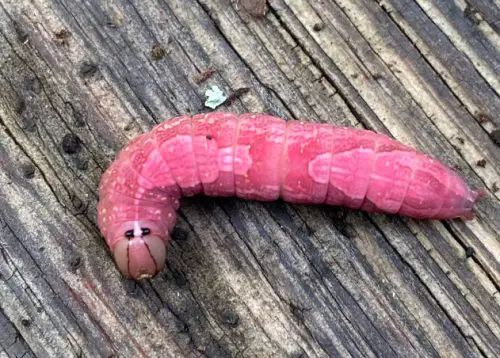
The White-Blotched Prominent Caterpillar (Heterocampa umbrata), native to the Eastern parts of North America, undergoes a remarkable transformation in color during its growth stages. Initially, it displays a distinctive dark uniform pink shade, later acquiring a light pink dorsal band. As it matures, the caterpillar transitions to green while maintaining a row of tiny pink lateral dots. The adult moths, when emerged, exhibit a mottled black, gray, and white coloration, devoid of the vivid hues seen in their earlier caterpillar stage. Belonging to the Notodontidae family, this moth is part of a broader group encompassing over 2,800 moths with similar appearances.
Indra Swallowtail Caterpillar
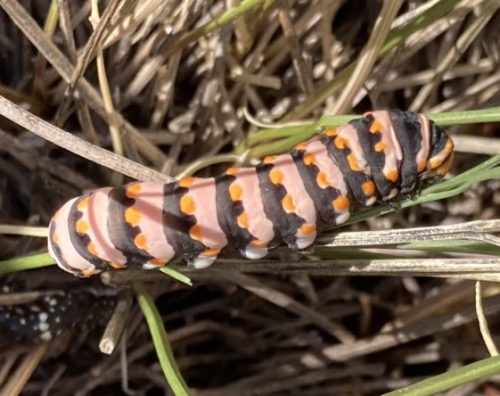
The transformation of the Indra Swallowtail Caterpillar (Papilio indra) unfolds as it matures, initially presenting itself in almost complete blackness with short, thick spines, accentuated only by tiny pink dots. As it progresses to its final instar, distinct pink and black alternating bands emerge. This species thrives in North American canyons, mountains, and deserts, with its presence intricately tied to host plants within the parsley family. In areas like California, Nevada, and Eastern states, the striking pink Indra Swallowtail Caterpillar can be easily spotted.
Mottled Prominent Caterpillar
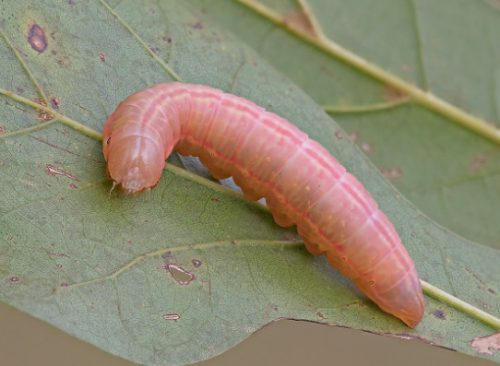
The Mottled Prominent Caterpillar (Macrurocampa marthesia) exclusively resides in the Eastern US, initiating its life as a green caterpillar before gradually revealing a distinctive mid-dorsal pink and white stripe. Employing green and pink hues, the caterpillar mimics the colors of leaves and veins. However, spotting this caterpillar is concerning, as it is a notorious pest for deciduous trees. Hardwoods like oak and even maple face significant impacts, often leading to complete defoliation due to the feeding habits of this species.
Tobacco Budworm
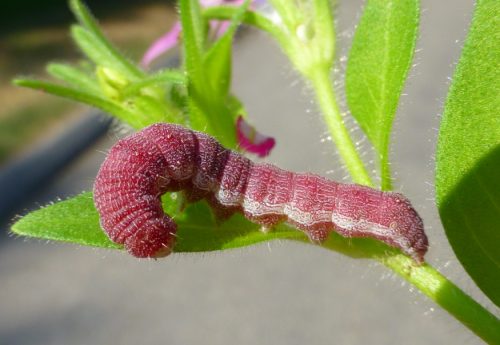
The Tobacco Budworm caterpillar (Chloridea virescens) poses a significant threat to tobacco crops, capable of consuming entire leaves. Its impact extends beyond tobacco, affecting crops like cabbage, cotton, and cantaloupe. Initially marked by pink, tan, white, and black coloring, the caterpillar later transforms into darker orange and black hues. The species exhibits high resistance to pesticides, raising concerns. Early management strategies include weed removal around major crops, aiming to mitigate the influence of this colorful but destructive species.
Banded Sphinx Caterpillar
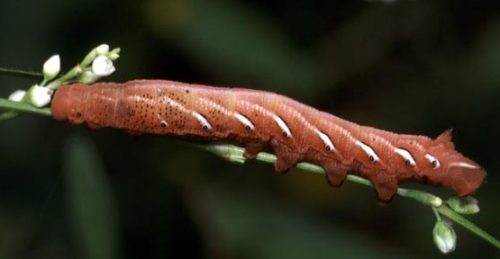
The Banded Sphinx Caterpillar (Eumorpha fasciatus) exhibits unique green and pink or green and red variations. The pink morph showcases broader pink sections on the body before pupation, with green on the lateral and ventral sides. Initially, the caterpillar features alternating green and pink bands with white diagonal stripes. Upon adulthood, the adult moth displays pink sections on both forewings and hindwings. This distinctive species is found in multiple Northern states, including Michigan.
Gray Hairstreak Caterpillar
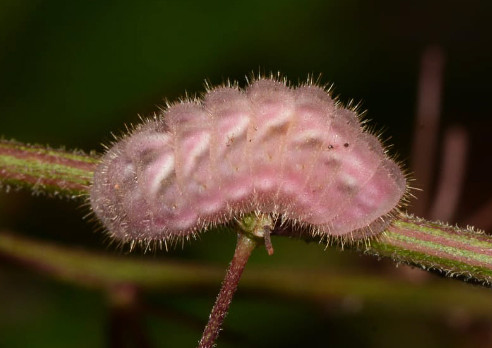
The Gray Hairstreak Caterpillar (Strymon melinus) exhibits a vibrant pink hue in its early stage, later transitioning to a pink and green appearance with lateral green coloring. Adult Gray Hairstreaks lack pink coloring and are characterized by shades of blue and gray. These caterpillars consume various clovers and cover crops, with preferences changing with age. While young caterpillars feed exclusively on small flowers, mature caterpillars can devour entire leaves. Found in open woodlands across both the Eastern and Western parts of the US, this species showcases a fascinating transformation in coloration.
Primrose Moth Caterpillar
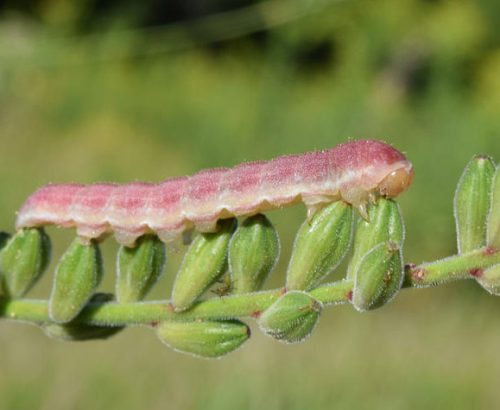
Primrose Moth Caterpillars (Schinia florida) inhabit Eastern and Northeastern regions of the US, displaying distinct morphs in green and pink with tiny white dots. Notably, this species exhibits pink coloring throughout its life stages, from caterpillar to emerging adult. The moth features pink forewings and white hindwings. Operating nocturnally, the Primrose Moth is active in a single annual brood, capable of overwintering in the caterpillar stage by retreating into the ground. This brood aligns with the flowering period of its preferred plants for sustenance.
Palm Flower Moth Caterpillar
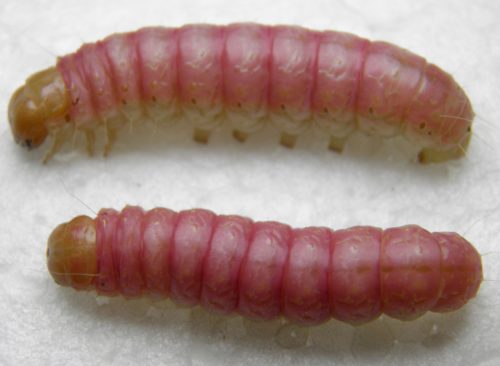
The fully grown Palm Flower Moth Caterpillar (Litoprosopus coachella) boasts a distinctive bright pink hue, initially darkening before brightening further with the emergence of white sections across its body. Populations of this species are notably stable in California, with occasional sightings in Nevada. The Mexican Fan Palm serves as a primary habitat, prevalent in the Southwestern US. Adult moths, in contrast, exhibit a cream-to-tan coloration, devoid of the vibrant pink hues seen in their larval stage.
Oblique Heterocampa Moth Caterpillar
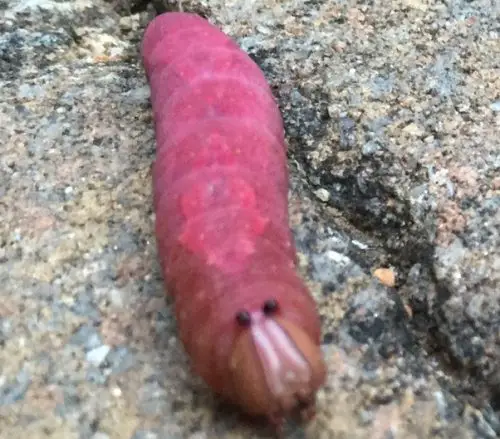
The Oblique Heterocampa Moth Caterpillar (Heterocampa obliqua) stands out among green species with its distinct pink dorsal patterns. Notably, the dorsal side displays intricate diamond-shaped pink patterns. In its early instars, a light base green color predominates, gradually darkening as the caterpillar matures. The initial pink head of the species undergoes a transformation, evolving into a blend of green and pink in the later growth stages. Additionally, the pink diamond-shaped sections on the dorsal side transition to white, contributing to the caterpillar’s evolving appearance.
Pink-Striped Oakworm
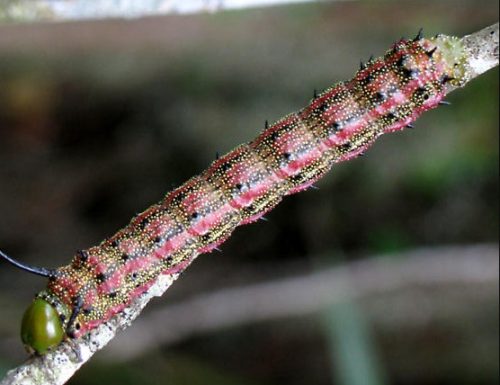
The invasive Pink-striped Oakworm caterpillars (Anisota virginiensis) pose a threat to North American woodlands, infiltrating diverse habitats and feeding voraciously on oak and hazel leaves. With a multicolored body adorned with wide pink stripes, dark gray or black hues, and delicate white dots, these caterpillars stand out. Their black spines and long antennae create a striking contrast with their vibrant coloring. Considered perilous, they have the potential to defoliate woodlands periodically, necessitating management strategies, including chemical sprays on home oak and hazel trees.
Drab Prominent Caterpillar
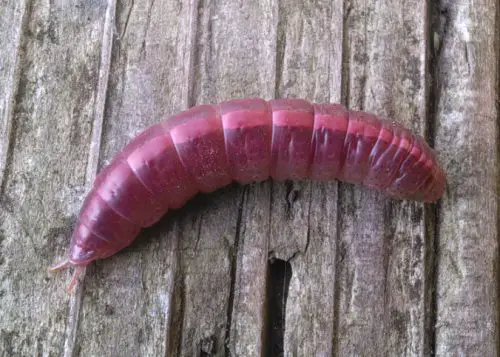
The Drab Prominent Caterpillar (Misogada unicolor) displays a unique transformation, initially adorned with a darker uniform pink color that later shifts to a vibrant green. In its secondary instars, a striking bright pink dorsal stripe emerges. These caterpillars exhibit a preference for poplar leaves, consuming the underside with their pink hue. As they ascend to the leaf’s top, their color transforms to green, offering effective camouflage. This remarkable adaptation showcases the intricate relationship between the caterpillar’s coloring and its feeding behavior.
Silvery Blue Caterpillar
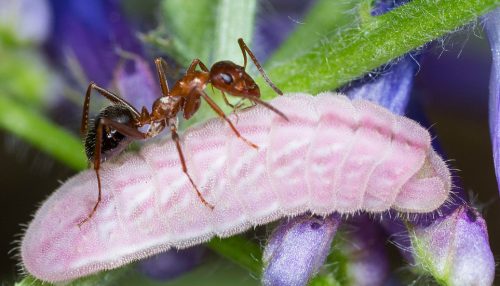
The Silvery Blue Caterpillar (Glaucopsyche lygdamus) undergoes a captivating transformation, commencing with vibrant light pink hues adorned with white sections in its early stages. As the caterpillar matures, this striking pink evolves into a verdant green. Contrary to its colorful larval stage, the adult Silvery Blue Butterfly exhibits a distinct blue and gray pattern on its ventral side. With a remarkable presence across various North American habitats, this sizable species maintains its above-average size, boasting a wingspan that can reach up to 28mm.
People Who Read This Also Read:

